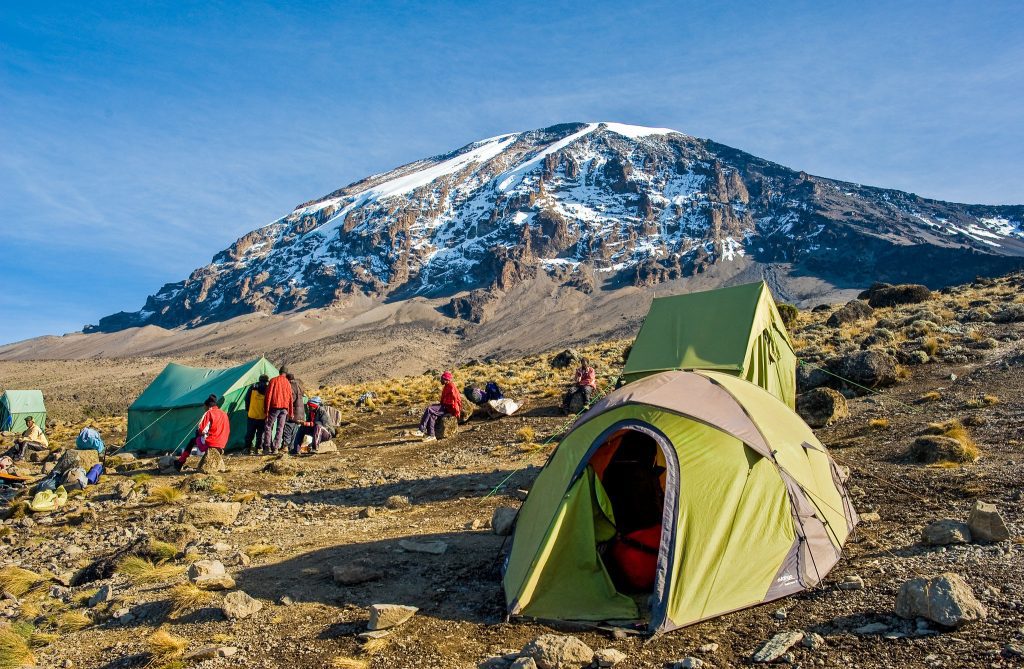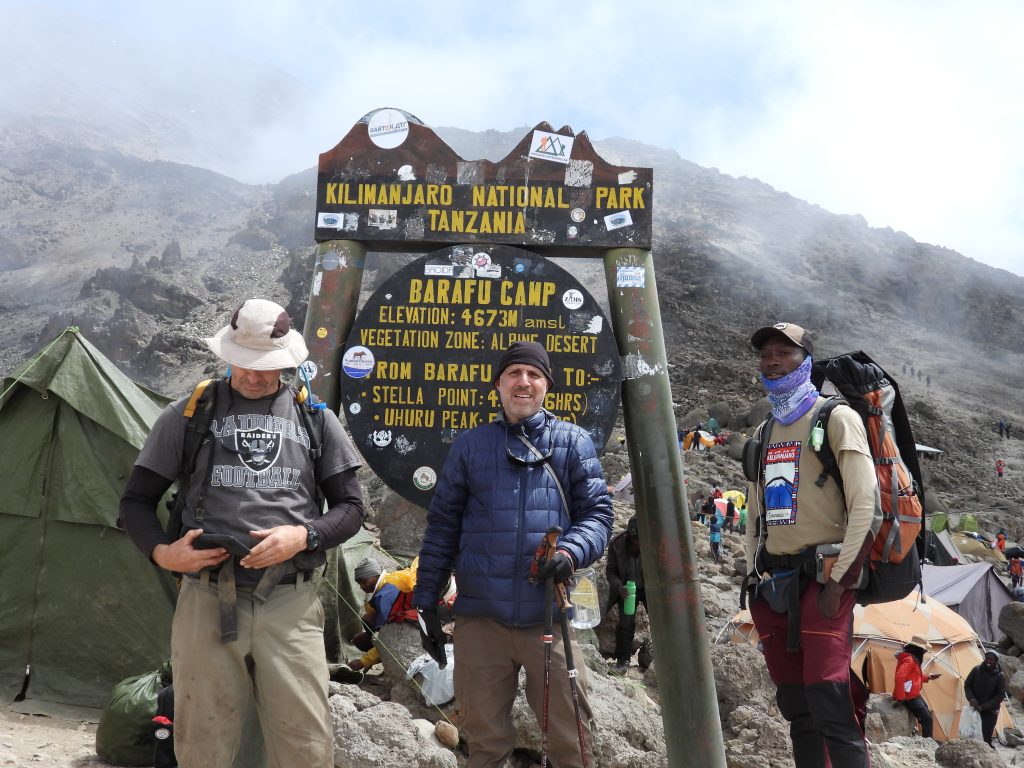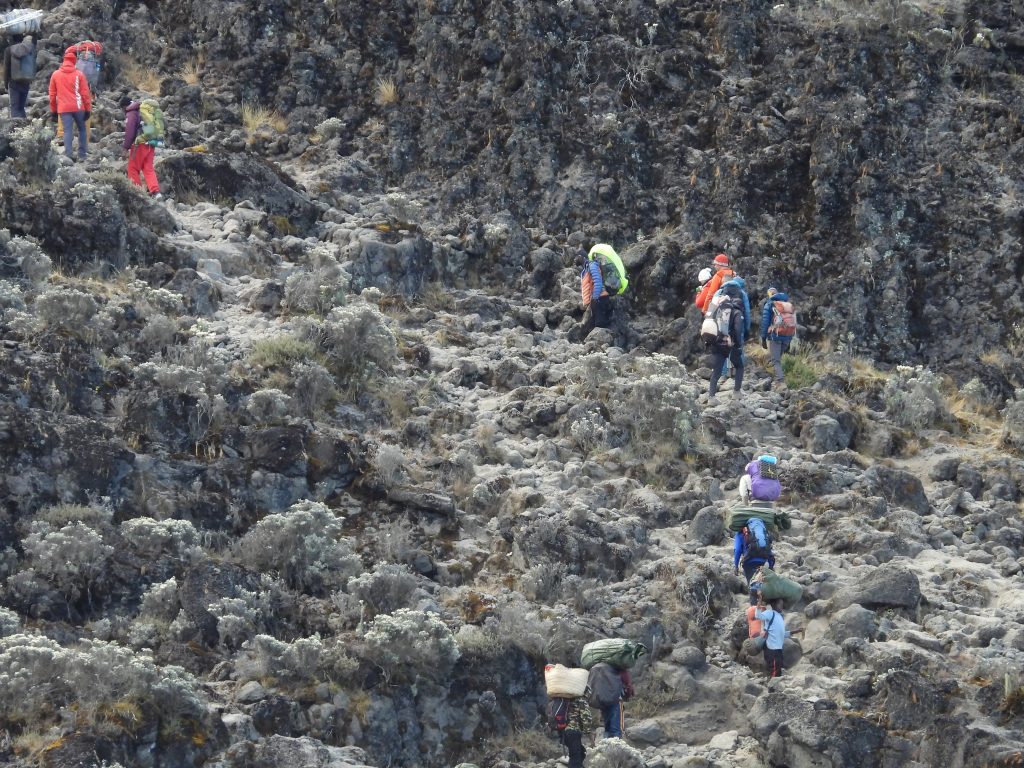
[gdlr_core_space height=”60px”]
How long does it take to hike to the top with Kilimanjaro Climbing?
The first question you’ll probably be asking yourself is how long will it take to get to the top. Of course, this all depends on which route you end up taking. So it’s always a good idea to plan your whole trip accordingly.
You may need up to nine days to handle the entire experience. Some routes will get you there in under a week, which is around five days. But be wary of those routes because Mt. Kilimanjaro is so high up that you may feel exhausted or nauseous due to the extreme altitude and rushing to the top.
Plus, you don’t need to rush everything when it comes to an adventure of a lifetime. Always consider taking one of the more extended route options. Most climbers take a route that lasts around seven days. This is the optimal time frame for the average person to have a successful trip.
Mt. Kilimanjaro is refereed as “the roof of Africa” since it is also the highest mountain in Africa. When it comes to freestanding mountains, this dormant volcano is actually the biggest in the world.
[gdlr_core_space height=”60px”]



[gdlr_core_space height=”60px”]
The major routes to the top for Kilimanjaro Climbing
There are around seven routes that you can take based on several factors. The duration, difficulty, and scenery you’re looking to get out of the trip. Keep in mind that each route can vary in length and difficulty. You also need to keep in mind the altitude sickness and how it may affect you.
It also depends on whether you’re looking to peacefully ascend the mountain or be part of the sometimes large swaths of people that may be climbing up the mountain at the same time.
Machame Route: The Most Climbed Route
The Machame Route is considered one of the most popular routes currently possible. It is a better option for tourists, than the previously most popular and also oldest route, the ‘Marangu route’. This is due to the fact that the climilb is more gradual, and therefore giving your body a chance to get used to the altitude. This route also offers beautiful views and unique hikes that the Marangu route will not offer.
You’ll still be able to camp and enjoy the surrounding nature as you trek your way up there. You will have a total travel time of around 7 days, climbing according to the ‘walk high, sleep low’ principle (explanation below). This gives your body a chance to acclimatize to the high altitude. The route starts on the southern side of the mountain. Keep in mind that the climb, despite its more gradual construction, will require a lot of effort. So prepare yourself.
It also depends on whether you’re looking to peacefully ascend the mountain or be part of the sometimes large swaths of people that may be climbing up the mountain at the same time.
Lemosho Route
This route has you coming in from the West and is one of the best options out there. The Lemosho Route usually attracts fewer people, as it is one of the newer, lesser-known routes. Although there is less climbing on this route, it is claimed to have the best views of all.
On this route, you can have the feeling of really being in the wilderness and one with nature. All alone, without being disturbed by other climbers. This is definitely one of the longer journeys. So it’s always a good idea to dedicate the full eight days to the hike. You can lessen it if necessary, but it may not give you the time to be able to enjoy everything.
The Northern Circuit Route
This is the longest, toughest, and most rewarding route that is currently possible when trekking Mount Kilimanjaro. This will require the nine days mentioned earlier and start off in the same area as the Lemosho Route.
This is a very scenic route, just like the Lemosho Route.
The Northern circuit, it’s also the one least promotes and used, meaning you’ll have a truly intimate experience with it. After the starting point, you split up with the Lemosho route group and go up the mountain via the north side. Due to the length of the climb, this route is the best possible option when it comes to acclimatization of the body.
Marangu Route
The Marangu route is the one to take for those who want a simple exploration expedition and sleep in huts during the journey. This is the oldest and simplest route and is called the ‘Coca-Cola route’’ because they’re commonly served as refreshments. It’s a short hike to the top that can be done in five days. But it’s always recommended to stay longer to acclimate.
Umbwe route
This is only for those hikers, climbers, and truly active people who have experience. It’s one of the shortest routes, with the least number of people taking it. It’s quite a challenge with a minimal success rate, primarily due to the steep climb and the lack of days to properly acclimate. Fair warning, as this route is truly a challenge and you need about six to seven days to complete it.
There’s also the possibility that due to the situation on the mountain, or with fellow travellers, including yourself, there may be a point that we’re not going to be able to reach the summit.
So although everything is done to make that a reality, we’re still talking about climbing a mountain. The trek may not be for everyone, so keep your expectations possible, but always do enjoy every aspect of the trip!
When is it a good time to go Kilimanjaro Climbing?
If you’re looking for the answer to when the least amount of other travellers will be there and the best type of weather, then you’re looking anywhere between January and March. It will be an acceptable temperature (not too hot), and you’ll still possibly see snow-capped peaks when you get to the top.
Of course, you’re approaching the rainy season if you head out anytime after that. So it’s still a good time, but the routes will be a lot muddier.
If you’re looking to come during the peak summer months (June through August), you’ll be able to enjoy the climb with other fellow travelers.
This can provide a unique bonding experience for those looking to meet like-minded adventurers such as yourself. On the flip side, if you’re hunting for a more private experience away from the beaten path, consider the Lemosho or Northern Circuit routes during this time-period.
How should I pack?
It’s best to pack like you’re going to go climb a mountain! That means packing the appropriate clothes and gear for both day and night. It will get very cold at night, so make sure you’ve got yourself a nice thermal sleeping bag. Also, the appropriate layers to wear as you get closer to the top. If you don’t have all the proper gear and don’t feel like buying it, we also rent out gear to make sure you can climb the mountain prepared.
Always make sure to have good containers to carry water as needed. Your guides will also help with any ancillary supplies.
How fit should I be?
Keep in mind that although you don’t need to be in peak physical condition, you do want to be in decent health and appropriate shape that comes with trying to hike a mountain.
Many of the routes are primarily simply walking and hiking the way up. If you’re in good physical condition, you shouldn’t have any major issues with the hike. However, you’ll find yourself enjoying the trip a lot more when you’re aware of this in advance.
If you feel comfortable with day-long hikes at home or have regular weekly aerobic exercise, where you’re able to run for a good 15 to 30 minutes, you shouldn’t have any issues with any of the major routes.
If you have any concerns, you’re always able to let us know in advance. We’ll let you know which ones are less strenuous than others.
Will I get altitude sickness while Kilimanjaro Climbing?
The peak of Kilimanjaro is almost 6000 meters. That means there’s a possibility that altitude sickness may occur on how some of the routes are done. We do our best to help mitigate it and follow the ‘walk high, sleep low’ principle. This is where we gradually scale the mountain and always make sure to sleep below the elevation we’ve hiked for that day.
That’s why the best option is at the least a seven-day planned route for those with little to no experience.
Your body will acclimate, so gradually build up your level of exertion and exercise. Otherwise, you will quickly become exhausted. So take it easy on the mountain; ‘one step, one breath’.
Another advice, is to keep drinking enough water during the journey. The air is much dryer as you go up, meaning you’re going to want to consume a lot more water than you may feel is normal. Always follow the instructions and tips from our guides if you want to increase your chances of success. They have climbed this mountain many times and know enough tips and tricks to keep the risk of altitude sickness as low as possible and make sure you reach the top!
It is also possible to train your body before the climb to get used to the high altitudes on the mountain. This can be done by regularly hiking at higher altitudes or by spending some time in a so-called ‘altitude tent’ before the climb. This will allow your body to get used to the climate on the mountain.
Feel free to reach out to us here, and we can start to discuss your Mount Kilimanjaro Climbing trip and all the different routes. We’ll work to fit your schedule and find the best trip for you.
Tailor Made Tours
Let’s plan your tailor made Tanzania Eco-Trip!
